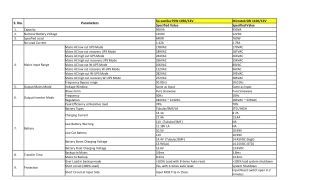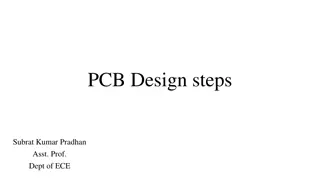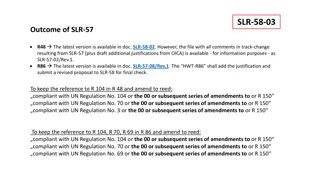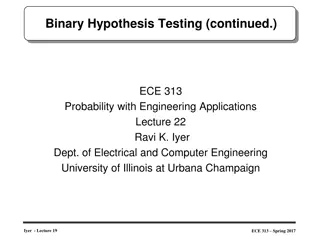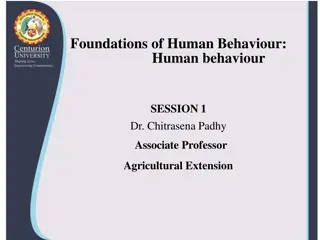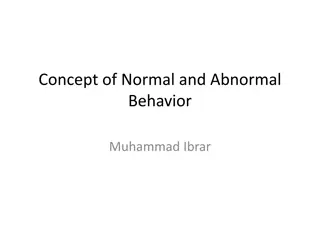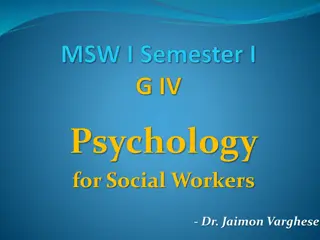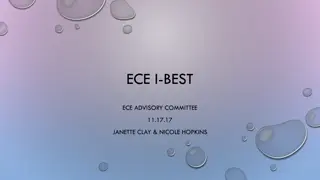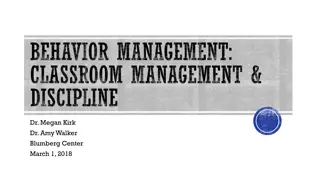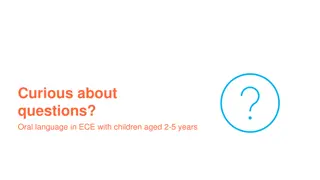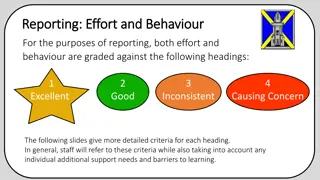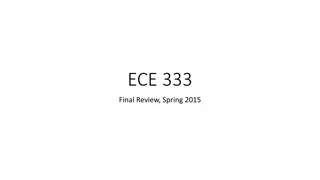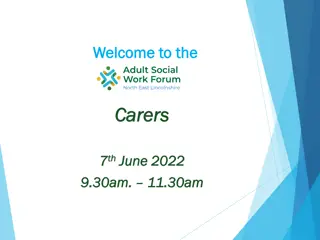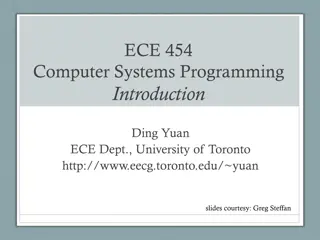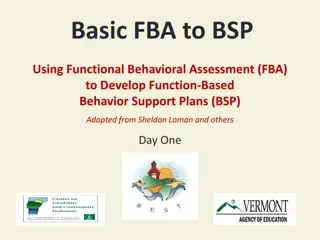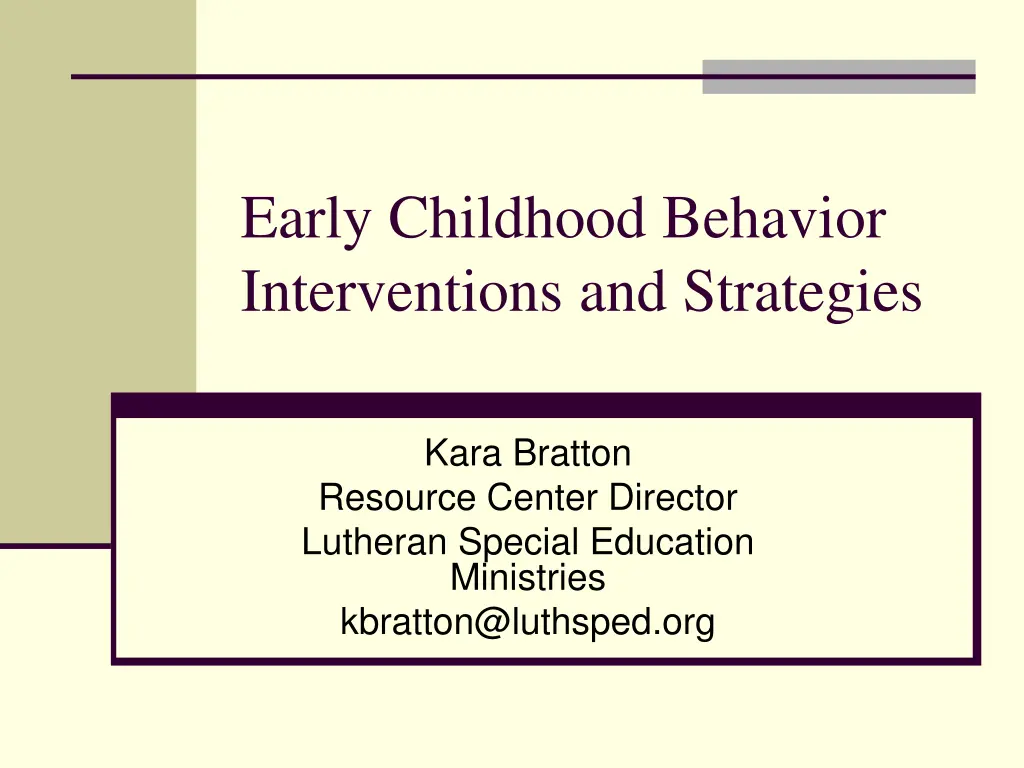
Effective Early Childhood Behavior Interventions and Strategies
Explore effective early childhood behavior interventions and strategies to support children's positive behavior development. Learn about positive behavior support, behavior hypotheses, prevention strategies, replacement skills, and responses to challenging behaviors.
Download Presentation

Please find below an Image/Link to download the presentation.
The content on the website is provided AS IS for your information and personal use only. It may not be sold, licensed, or shared on other websites without obtaining consent from the author. If you encounter any issues during the download, it is possible that the publisher has removed the file from their server.
You are allowed to download the files provided on this website for personal or commercial use, subject to the condition that they are used lawfully. All files are the property of their respective owners.
The content on the website is provided AS IS for your information and personal use only. It may not be sold, licensed, or shared on other websites without obtaining consent from the author.
E N D
Presentation Transcript
Early Childhood Behavior Interventions and Strategies Kara Bratton Resource Center Director Lutheran Special Education Ministries kbratton@luthsped.org
Positive Behavior Support If a child doesn t know how to read, we teach. If a child doesn t know how to swim, we teach. If a child doesn t know how to multiply, we teach. If a child doesn t know how to drive, we teach. If a child doesn t know how to behave, we........... ..........teach? .........punish? Why can t we finish the last sentence as automatically as we do the others? Tom Herner (NASDE President ) Counterpoint 1998, p.2
Positive Behavior Support Behavior Hypotheses/Function of Behavior - Purpose of the behavior, your best guess about why the behavior occurs Prevention Strategies - Ways to make events and interactions that trigger challenging behavior easier for the child to manage Replacement Skills New skills to teach throughout the day to replace the challenging behavior Responses - What adults will do when the challenging behavior occurs to ensure that the challenging behavior is not maintained and the new skill is learned
Changing Our View of Challenging Behavior Understand why challenging behaviors happen and what purpose they serve Focus on developing a broader range of skills and outcomes for children Implement interventions for these behaviors at an early age that help children learn new behaviors Develop preventative interventions that are practical and ongoing
Changing Our View of Challenging Behavior Take the problem away from how it impacts you and others and ask: Why is this behavior occurring? What is happening from the child s perspective that is triggering the behavior? What changes can I make to prevent the problem from occurring and teach the child new skills? (http://challengingbehavior.fmhi.usf.edu/explore/presentation_docs/9.04_addressing_challenging.pdf)
Functional Behavioral Assessments Behavior is a means of communication; undesirable behavior satisfies some kind of need for the student Behavior leads to response Behavior is an attempt to obtain a response or gain something This is determining the reason and function of the undesirable behavior Behavior will not change unless the student s need (function of behavior) is determined and more appropriate way to meet that need is found Behavior learned over time and through experiences, shaped by what happens before and after behavior takes place How we respond to actions has a significant effect on what child does next time he/she is in a similar situation
Functional Behavioral Assessments ABC s of FBAs Antecedent: factors in the environment present before the behavior occurs Physical environment, instructional factors, subject, activity, size of group, who is/is not present, noise, location, time of day Anything specific to that student such as level of fatigue, hunger, etc. Behavior: what the student does, and/or does not do Consequence: what happens after the behavior Includes actions of teachers, peers, things the student avoids or obtains, changes in the environment
Functional Behavioral Assessments What happens after behavior occurs; what is helping the behavior persist and maintaining the behavior/making it a tool for the individual What do you typically do to get the child to stop engaging in the behavior? Is your response allowing the behavior to continue/child getting what they want?
Functional Behavioral Assessments Date Time Antecedent Behavior Comments Consequence
Functions of Behavior Escape Desire to get away from a person, activity, or setting Example: Student runs out of the classroom Attention Desire for attention from others; may or may not be a specific person or group Example: Student making jokes while teacher is talking Sensory Desire to obtain or get away from a particular sensory experience Example: Student has trouble in the crowded lunchroom Tactile Desire for a specific item Example: Student pushes or hits to get a particular classroom item
Functions of Behavior Take a step back and consider why a child may be behaving in a certain way-first step in understanding and learning how to help; also consider potential physical/medical factors Helpful to think of an individual s actions as a response rather than a pre-determined or willful behavior
Functions of Behavior The same behavior that serves one function in one situation may serve a different purpose in a different setting Example: Biting out of frustration when child wants something they can not ask for (tangible) Biting to get away from a person or activity (escape)
Functions of Behavior Behavior Possible Function Escape lunch room Gain attention Escape gym class (motor activities) Gain access to desirable item Get help from parent Gain sensory stimulation Escape activity Gain attention from adults and peers Escape demands (academic) Yelling Hitting Calling Out
Teaching Replacement Behaviors Three essential characteristics of replacement behaviors Same function as the problem behavior Easier to do than the problem behavior Socially acceptable
Teaching Replacement Behaviors Replacement behaviors meet the same need/have the same function as undesirable behavior Meet the need/function in a more appropriate way Intervention should increase the use of the replacement behavior Consider whether the student needs to be taught how to perform the replacement behavior, or whether the student knows how to perform the desired behavior
Teaching Replacement Behaviors When the function is appropriate but the form is not appropriate What can I teach as a replacement behavior for the challenging behavior that addresses the same outcome? Choosing a replacement behavior Find a behavior that serves the same purpose or function as the challenging behavior Teach a behavior that helps the child achieve the purpose easier, quicker, and better than the challenging behavior Reinforce the replacement behavior and make sure challenging behavior is not being reinforced
Teaching Replacement Behaviors Don t assume child has skills needed to do something the right way Use instruction, motivation and reinforcement to build new abilities Teach new skills in a positive learning situation, not while behavior is occurring
Reinforcing Behavior Example: Child hitting to avoid cleaning up toys- escape function Putting child in time out reinforces desire to escape and avoid the task Likely the child will continue hitting If removal is necessary for safety, child still has to come back to task so escape is not reinforced Kicks every time it s time for circle time If reason for kicking was to avoid circle time, putting in time out reinforces kicking Child likely to use same form of communication unless and until he/she is taught a better way of approaching situation
Punishment vs. Reinforcement Short term consequences of punishment may stop behavior in the moment Research shows that punishment is ineffective in the long run, especially when not used with positive and preventive approaches Punishment promotes emotional responses (crying) and aggressive behavior; also promotes desire for escape and avoidance of person or situation
Punishment vs. Reinforcement Punishment does not teach what to do, but teaches what not to do Reinforcement consistently changes behavior and builds desired responses Reinforce immediately and in connection with desired behavior Learn what is reinforcing to each child, may change frequently
Punishment vs. Reinforcement While positive, reinforcement-based strategies are most effective in creating long term behavioral changes, immediate responses are still needed to maintain safety and/or minimize disruption Ignoring the behavior (when not threatening and behavior is being used for attention) Redirection to appropriate behavior with reinforcement Removal from situation Positive practice or do-overs rather than punish to teach appropriate behavior
Behavior Interventions Effective interventions shift the payoff so that it occurs for positive behaviors, and no payoff happens for negative behaviors Achieved through teaching replacement behaviors Behavior Intervention Plans typically fail either because the function has not been properly identified or the plan was not implemented completely and consistently Expect a decrease in frequency of behavior, but then a slight increase Over time, undesirable behavior will decrease and positive behavior will increase but it does not happen overnight Continue intervention even as behaviors begin to decrease
Behavior Interventions New skills take time to develop In some cases, especially when ignoring behavior, behavior may become more intense or more frequent before it improves Prioritize which behaviors to address and be realistic about outcomes
Behavior Interventions Teaching Tools for Young Children with Challenging Behavior (http://challengingbehavior.fmhi.usf.edu/do/resources/teaching_tools/ttyc_updated_zi p.htm) Folder 1- Tips/Forms, File E Events and Functions Associated with Problem Behavior Use forms to identify trigger(s), what skills need to be addressed, what types of responses maintain the behavior, and the function of behavior Select appropriate strategies from TTYC Routine Based Support Guide (Folder 1, File G) Strategies include 12 common routines found in preschools Make sure chosen strategies match child s communication and cognitive level and take into account their preferences Strategies need to be implemented effectively and may take time; will not always get instant results, but don t give up!
Behavior Strategies- Proactive Interventions To develop an intervention ask yourself... What can I do to change the behavior? How can I modify or change the factors that contribute to the behavior? What can I teach the child to use as a replacement behavior that addresses the same purpose or outcome? How will I teach the replacement behavior to the child? How can I make sure that I am NOT reinforcing the outcome of the challenging behavior? How can I reinforce the replacement behavior so that it matches the function of the challenging behavior?
Behavior Strategies Use cards to reduce behaviors Example: student talks during class; monitor how many times/day this happens and give student less cards to begin; every time behavior happens, student has to give teacher a card; student will learn he/she can not do that once out of cards; over time cards are reduced; provide reinforcement as appropriate
Example 1 Jared talks out at least two times per class. He smiles, and other students snicker, when his teacher reminds him to raise his hand. Since the beginning of the year, the problem seems worse. Do the reminders reinforce or punish him? How do you know? What might be the function of this behavior?
Example 2 Colleen has an argument with someone in the cafeteria at least 3 times per week. The consequence is to stay in at recess and read or work on the computer with the teacher. Is the consequence serving as a reward or punisher? What might the function of Colleen s behavior be?
Scenario #1 Tisha, a three year old with ASD, is building a block structure during work time. Her teacher tells the group that work time will be ending in 5 minutes. Tisha is not finished with her structure. When work time is over the teacher reminds the kids to clean up their work and put their materials away. Tisha starts kicking and screaming, hitting anyone who is near her. She hits the teacher who comes to tell her it is time to clean up. The teacher takes the blocks and puts them in the container, leaving a few for Tisha to put away. Tisha continues to kick and scream. This happens each time Tisha is reminded to clean up her work.
Antecedent Conse- quences Behavior Reinforce- ment or Punish- ment Function of Behavior Replace- ment Behaviors
Scenario #2 Bob, a young man with Asperger Syndrome, yells out This is stupid when given an assignment in his inclusive social studies class. His teacher calls his name sternly and tells him that he has a WARNING. After a few minutes, Bob yells again I don t want to do this pathetic work . The teacher yells at Bob and gives him STRIKE 1. After a few more minutes, Bob yells, Only a moron would want to write about the Aztecs . The teacher yells again, saying he is sick of Bob s comments, Bob has a bad attitude, Bob has no consideration for his classmates, etc. and gives Bob STRIKE 2. Each time Bob comments, the teacher yells and gives him a strike. Bob behaves this way at least one time per day.
Antecedent Conse- quences Behavior Reinforce- ment or Punish- ment Function of Behavior Replace- ment Behaviors
Scenario #3 Whenever Susie is given written tests, she both scribbles her name on the test and pushes it aside or she crumbles the test into a ball and throws it away. Her teacher tells her that she will receive a zero on the test, that she is failing the class, that she should have at least made an effort. The teacher also required that Susie spend the rest of the class time sitting quietly at her desk and not disturbing others.
Antecedent Conse- quences Behavior Reinforce- ment or Punish- ment Function of Behavior Replace- ment Behaviors
Your Scenario Think of a student in your classroom with challenging behavior Complete as much of the ABC chart as you can to determine the function of the behavior After you have determined the function, identify some potential interventions and replacement behaviors that may be effective at decreasing the undesired behavior
Antecedent Conse- quences Behavior Reinforce- ment or Punish- ment Function of Behavior Replace- ment Behaviors
Positive Behavior Supports Celebrate and build strengths and successes More positive than negative feedback Respect and listen to child Verbal as well as other communication from child Validate child s concerns and emotions Do not brush aside fears or simply say don t worry Provide clear expectations with visual supports
Positive Behavior Supports Set child up for success with accommodations Ignore challenging behavior Interact at the child s level to avoid frustration Give choices as appropriate Provide access to breaks Teach child to request break Use a safe, calm down space as a positive strategy, not punishment Utilize reinforcement
Positive Behavior Supports Pick your battles Use positive proactive language (avoid don t )
Please contact LSEM and let us know how we can support your ministry! lsem@luthsped.org 248-419-3390

